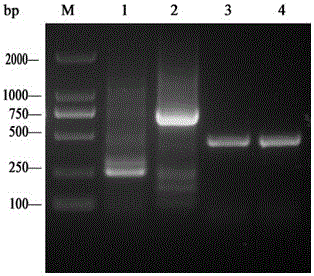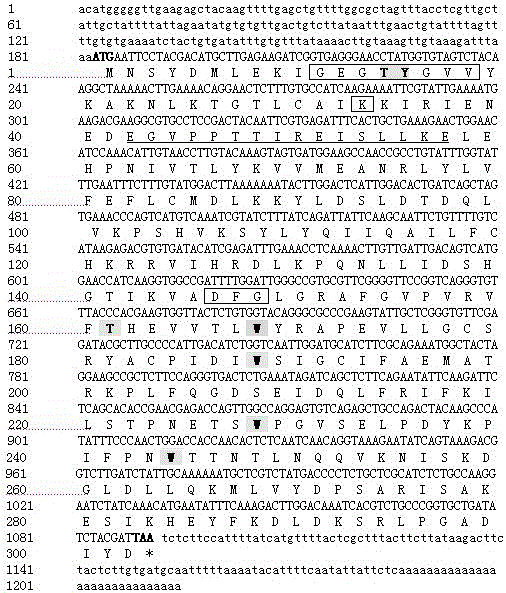The brown planthopper nlcdc2 gene and its encoded product and application
A brown planthopper, gene technology, applied in application, genetic engineering, plant genetic improvement and other directions, can solve problems such as difficulty in adopting targeted strategies and lack of target information
- Summary
- Abstract
- Description
- Claims
- Application Information
AI Technical Summary
Problems solved by technology
Method used
Image
Examples
Embodiment 1
[0026] Embodiment 1: brown planthopper Nlcdc 2 Gene cloning and sequence analysis
[0027] 1, Nlcdc2 RACE PCR and PCR amplification of core fragments
[0028] The N. lugens cDNA was used as a template, and the core sequence was amplified by PCR with primers Nlcdc2-F1 and Nlcdc2-R1 (Table 1), and the target fragment of the expected size was obtained. The sequencing results showed that the fragment was about 500 bp in size, and compared with the transcriptome Provides sequence consensus ( figure 1 ). After NCBI Blastp analysis, it was found that the deduced amino acid sequence of the gene was similar to that of Monarch butterfly Danaus plexippus (EHJ71170) homologous gene coded amino acid sequence homology reached 71%, as shown in Table 2. According to the core sequence sequencing results, RACE primers (Table 1) were designed to clone the full-length cDNA. 5'RACE obtained a specific sequence of about 750 bp, and 3'RACE obtained a specific sequence of about 250 bp ( f...
Embodiment 2
[0040] Example 2: Different developmental stages Nlcdc 2 mRNA expression levels
[0041] 1. Brown planthopper Nlcdc2 with β-actin Real-time PCR primer amplification efficiency
[0042] The N. lugens cDNA template was diluted 4 times, and 6 gradients were diluted. The abscissa of the standard curve is the logarithmic value of the dilution factor, and the ordinate is the CT value. Nlcdc2 with β-actin Fluorescent quantitative PCR standard curve ( Figure 4 ).
[0043] Real-Time PCR judges the specificity of primers by melting curves. Nlcdc2 with β-actin The melting curve shows that the product is single and there is no non-specific amplification ( Figure 5 ), and the results can be used for later data analysis.
[0044] 2. Different stages of development Nlcdc2 expression analysis of
[0045] Developmental stages of brown planthopper nymphs and brachypterous females using fluorescent quantitative PCR Nlcdc2 Quantification of transcript levels showed that Nlcdc2...
Embodiment 3
[0046] Embodiment 3: Synthesis and RNA interference of brown planthopper dsRNA
[0047] 1. Synthesis of dsRNA from brown planthopper
[0048] Use primers dsNlcdc2-F, dsNlcdc2-R and dsGFP-F, dsGFP-R (Table 1) to synthesize the fragment dsNlcdc2 for Nlcdc2 RNA interference and the non-target control interference fragment dsGFP respectively, and the results of RNA electrophoresis obtained fragments of the expected size, among which the dsNlcdc2 fragment The length is about 500 bp, and the length of the dsGFP fragment is 350 bp ( Figure 7 ).
[0049] 2. The effect of feeding dsRNA on the survival rate of brown planthopper
[0050] The artificial diet with a final concentration of 0.5 μg / μL dsGFP was used as the non-target control group (dsGFP), and the artificial diet with a final concentration of 0.5 μg / μL dsNlcdc2 was used as the test group (dsNlcdc2-1). Survival rates were counted daily. The results showed that there were significant differences between dsNlcdc2 test group...
PUM
| Property | Measurement | Unit |
|---|---|---|
| molecular weight | aaaaa | aaaaa |
Abstract
Description
Claims
Application Information
 Login to View More
Login to View More - R&D
- Intellectual Property
- Life Sciences
- Materials
- Tech Scout
- Unparalleled Data Quality
- Higher Quality Content
- 60% Fewer Hallucinations
Browse by: Latest US Patents, China's latest patents, Technical Efficacy Thesaurus, Application Domain, Technology Topic, Popular Technical Reports.
© 2025 PatSnap. All rights reserved.Legal|Privacy policy|Modern Slavery Act Transparency Statement|Sitemap|About US| Contact US: help@patsnap.com



